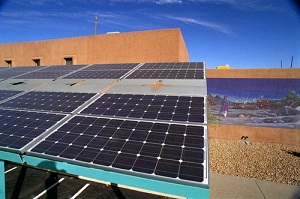New Mexico utility addressing intermittent issues in solar
 New Mexico utility PNM’s Prosperity Energy Storage project will address one of the most daunting problems facing wind and solar power today—how to integrate intermittent electric sources into the electric grid without using more gas- or coal-fired power. The short answer—batteries.
New Mexico utility PNM’s Prosperity Energy Storage project will address one of the most daunting problems facing wind and solar power today—how to integrate intermittent electric sources into the electric grid without using more gas- or coal-fired power. The short answer—batteries.
“When we create a firm, dispatchable renewable resource—when we can dispatch exactly when we need electric—then we can firmly state that we can preclude the future use of fossil fuel peaking resources,” said Steve Willard, PNM’s Prosperity project leader.
PNM has partnered with the University of New Mexico, Northern New Mexico College and Sandia National Labs to develop the Prosperity project. The pilot project is funded in part by a $2 million DOE grant and will allow for extensive system modeling, data collection, analysis and algorithm development, explained Willard.
The Prosperity project is expected to go online in summer 2011. It will integrate a 6-acre, 500 kilowatt photovoltaic system with 2 to 4 megawatt hours of battery storage. The battery system will store electricity produced by the array to load-shift and smooth the power that the system puts on the grid.
“The batteries are doing a couple things. They’re dedicated to smoothing out the output of PV,” Willard said. “The 2 to 4 megawatt hours is what we need to store about 2 to 4 hours worth of that array’s output. It addresses the need to shift that energy to deliver it to the grid when it’s much more beneficial.”
He explained that the system uses two types of batteries.
One type is integrated with super-capacitors and can quickly respond to changes in the amount of electricity produced by the array, hence smoothing the amount of electricity the system puts on the grid.
The second type of battery allows for load-shifting, so energy produced when the sun first hits the PV-array can be stored and used when it’s more needed.
“Solar peaks before the [grid] system does,” said Willard. “We consistently see system peaks that are two to three hours after that.”
He said it takes a while for buildings to heat up under New Mexico’s strong sun. But when the sun heats the buildings up, and occupants turn up the air conditioning, that’s when the second type of batteries will kick in to add power to the grid.
When the demonstration project is completed, according to Willard, it will demonstrate the benefits of production and storage systems.
“It’ll package a controller and give a great insight on how to control these [forms of generation],” he said. “When we have the model and algorithms, it will make the project more valuable to other utilities.”
Image courtesy of NREL.



